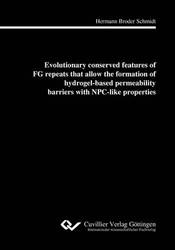| Departments | |
|---|---|
| Book Series (96) |
1378
|
| Nachhaltigkeit |
3
|
| Gesundheitswesen |
1
|
| Humanities |
2363
|
| Natural Sciences |
5406
|
| Mathematics | 229 |
| Informatics | 319 |
| Physics | 980 |
| Chemistry | 1363 |
| Geosciences | 131 |
| Human medicine | 243 |
| Stomatology | 10 |
| Veterinary medicine | 108 |
| Pharmacy | 147 |
| Biology | 835 |
| Biochemistry, molecular biology, gene technology | 121 |
| Biophysics | 25 |
| Domestic and nutritional science | 45 |
| Agricultural science | 1004 |
| Forest science | 201 |
| Horticultural science | 20 |
| Environmental research, ecology and landscape conservation | 148 |
| Engineering |
1791
|
| Common |
98
|
|
Leitlinien Unfallchirurgie
5. Auflage bestellen |
|
Advanced Search
Evolutionary conserved features of FG repeats that allow the formation of hydrogel-based perme-ability barriers with NPC-like properties (English shop)
Hermann Broder Schmidt (Author)Preview
Extract, PDF (460 KB)
Table of Contents, PDF (110 KB)
Non-globular FG domains constitute the permeability barrier of nuclear pore complexes (NPCs), which control all macromolecular exchange between nucleus and cytoplasm. Whilst objects smaller than 30kDa can passively diffuse across this barrier, larger molecules need to be chaperoned by nuclear transport receptors (NTRs). However, the modus operandi and, inextricably linked, the exact physical nature of the NPC permeability barrier are still controversially discussed. Whereas so far, most studies exclusively focused on yeast or vertebrate FG domains, the ability of FG domains from different species to form selective barriers was explored here. Interestingly, all studied species contain ‘cohesive’ FG domains that interact with each other to form a characteristic (hydrogel) phase mimicking the permeability properties of NPCs.
| ISBN-13 (Hard Copy) | 9783954044917 |
| Final Book Format | A5 |
| Language | English |
| Page Number | 172 |
| Lamination of Cover | matt |
| Edition | 1. Aufl. |
| Publication Place | Göttingen |
| Place of Dissertation | Göttingen |
| Publication Date | 2013-08-23 |
| General Categorization | Dissertation |
| Departments |
Biochemistry, molecular biology, gene technology
|
| Keywords | Nuclear pore, nuclear transport, FG repeats, permeability barrier, hydrogels |








